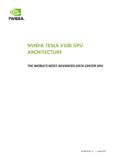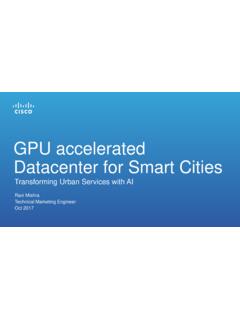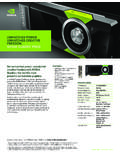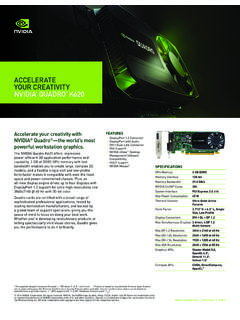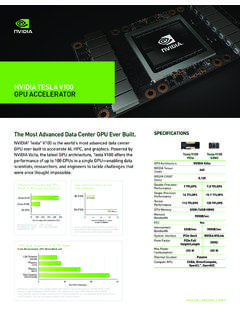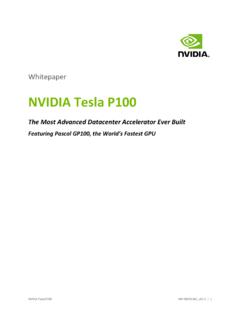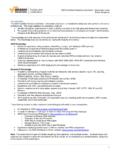Transcription of End to End Learning for Self-Driving Cars - Nvidia
1 End to End Learning for Self-Driving cars Mariusz Bojarski Davide Del Testa Daniel Dworakowski Bernhard Firner Nvidia Corporation Nvidia Corporation Nvidia Corporation Nvidia Corporation Holmdel, NJ 07735 Holmdel, NJ 07735 Holmdel, NJ 07735 Holmdel, NJ 07735. [ ] 25 Apr 2016. Beat Flepp Prasoon Goyal Lawrence D. Jackel Mathew Monfort Nvidia Corporation Nvidia Corporation Nvidia Corporation Nvidia Corporation Holmdel, NJ 07735 Holmdel, NJ 07735 Holmdel, NJ 07735 Holmdel, NJ 07735. Urs Muller Jiakai Zhang Xin Zhang Jake Zhao Nvidia Corporation Nvidia Corporation Nvidia Corporation Nvidia Corporation Holmdel, NJ 07735 Holmdel, NJ 07735 Holmdel, NJ 07735 Holmdel, NJ 07735. Karol Zieba Nvidia Corporation Holmdel, NJ 07735. Abstract We trained a convolutional neural network (CNN) to map raw pixels from a sin- gle front-facing camera directly to steering commands. This end-to-end approach proved surprisingly powerful. With minimum training data from humans the sys- tem learns to drive in traffic on local roads with or without lane markings and on highways.
2 It also operates in areas with unclear visual guidance such as in parking lots and on unpaved roads. The system automatically learns internal representations of the necessary process- ing steps such as detecting useful road features with only the human steering angle as the training signal. We never explicitly trained it to detect, for example, the out- line of roads. Compared to explicit decomposition of the problem, such as lane marking detec- tion, path planning, and control, our end-to-end system optimizes all processing steps simultaneously. We argue that this will eventually lead to better perfor- mance and smaller systems. Better performance will result because the internal components self -optimize to maximize overall system performance, instead of op- timizing human-selected intermediate criteria, e. g., lane detection. Such criteria understandably are selected for ease of human interpretation which doesn't auto- matically guarantee maximum system performance. Smaller networks are possi- ble because the system learns to solve the problem with the minimal number of processing steps.
3 We used an Nvidia DevBox and Torch 7 for training and an Nvidia . DRIVETM PX Self-Driving car computer also running Torch 7 for determining where to drive. The system operates at 30 frames per second (FPS). 1. 1 Introduction CNNs [1] have revolutionized pattern recognition [2]. Prior to the widespread adoption of CNNs, most pattern recognition tasks were performed using an initial stage of hand-crafted feature extrac- tion followed by a classifier. The breakthrough of CNNs is that features are learned automatically from training examples. The CNN approach is especially powerful in image recognition tasks be- cause the convolution operation captures the 2D nature of images. Also, by using the convolution kernels to scan an entire image, relatively few parameters need to be learned compared to the total number of operations. While CNNs with learned features have been in commercial use for over twenty years [3], their adoption has exploded in the last few years because of two recent developments.
4 First, large, labeled data sets such as the Large Scale Visual Recognition Challenge (ILSVRC) [4] have become avail- able for training and validation. Second, CNN Learning algorithms have been implemented on the massively parallel graphics processing units (GPUs) which tremendously accelerate Learning and inference. In this paper, we describe a CNN that goes beyond pattern recognition. It learns the entire pro- cessing pipeline needed to steer an automobile. The groundwork for this project was done over 10. years ago in a Defense Advanced Research Projects Agency (DARPA) seedling project known as DARPA Autonomous Vehicle (DAVE) [5] in which a sub-scale radio control (RC) car drove through a junk-filled alley way. DAVE was trained on hours of human driving in similar, but not identical en- vironments. The training data included video from two cameras coupled with left and right steering commands from a human operator. In many ways, DAVE-2 was inspired by the pioneering work of Pomerleau [6] who in 1989 built the Autonomous Land Vehicle in a Neural Network (ALVINN) system.
5 It demonstrated that an end-to- end trained neural network can indeed steer a car on public roads. Our work differs in that 25 years of advances let us apply far more data and computational power to the task. In addition, our experience with CNNs lets us make use of this powerful technology. (ALVINN used a fully-connected network which is tiny by today's standard.). While DAVE demonstrated the potential of end-to-end Learning , and indeed was used to justify starting the DARPA Learning Applied to Ground Robots (LAGR) program [7], DAVE's performance was not sufficiently reliable to provide a full alternative to more modular approaches to off-road driving . DAVE's mean distance between crashes was about 20 meters in complex environments. Nine months ago, a new effort was started at Nvidia that sought to build on DAVE and create a robust system for driving on public roads. The primary motivation for this work is to avoid the need to recognize specific human-designated features, such as lane markings, guard rails, or other cars , and to avoid having to create a collection of if, then, else rules, based on observation of these features.
6 This paper describes preliminary results of this new effort. 2 Overview of the DAVE-2 System Figure 1 shows a simplified block diagram of the collection system for training data for DAVE-2. Three cameras are mounted behind the windshield of the data-acquisition car. Time-stamped video from the cameras is captured simultaneously with the steering angle applied by the human driver. This steering command is obtained by tapping into the vehicle's Controller Area Network (CAN). bus. In order to make our system independent of the car geometry, we represent the steering com- mand as 1 /r where r is the turning radius in meters. We use 1 /r instead of r to prevent a singularity when driving straight (the turning radius for driving straight is infinity). 1 /r smoothly transitions through zero from left turns (negative values) to right turns (positive values). Training data contains single images sampled from the video, paired with the corresponding steering command (1 /r ). Training with data from only the human driver is not sufficient.
7 The network must learn how to recover from mistakes. Otherwise the car will slowly drift off the road. The training data is therefore augmented with additional images that show the car in different shifts from the center of the lane and rotations from the direction of the road. 2. Left camera Center camera Right camera Steering wheel angle (via CAN bus). External solid-state drive for data storage Nvidia DRIVETM PX. Figure 1: High-level view of the data collection system. Images for two specific off-center shifts can be obtained from the left and the right camera. Ad- ditional shifts between the cameras and all rotations are simulated by viewpoint transformation of the image from the nearest camera. Precise viewpoint transformation requires 3D scene knowledge which we don't have. We therefore approximate the transformation by assuming all points below the horizon are on flat ground and all points above the horizon are infinitely far away. This works fine for flat terrain but it introduces distortions for objects that stick above the ground, such as cars , poles, trees, and buildings.
8 Fortunately these distortions don't pose a big problem for network train- ing. The steering label for transformed images is adjusted to one that would steer the vehicle back to the desired location and orientation in two seconds. A block diagram of our training system is shown in Figure 2. Images are fed into a CNN which then computes a proposed steering command. The proposed command is compared to the desired command for that image and the weights of the CNN are adjusted to bring the CNN output closer to the desired output. The weight adjustment is accomplished using back propagation as implemented in the Torch 7 machine Learning package. Recorded steering wheel angle Adjust for shift Desired steering command and rotation Network Left camera computed steering Center camera Random shift and rotation CNN. command - Right camera Back propagation Error weight adjustment Figure 2: Training the neural network. Once trained, the network can generate steering from the video images of a single center camera.
9 This configuration is shown in Figure 3. 3. Network computed steering command Drive by wire Center camera CNN. interface Figure 3: The trained network is used to generate steering commands from a single front-facing center camera. 3 Data Collection Training data was collected by driving on a wide variety of roads and in a diverse set of lighting and weather conditions. Most road data was collected in central New Jersey, although highway data was also collected from Illinois, Michigan, Pennsylvania, and New York. Other road types include two-lane roads (with and without lane markings), residential roads with parked cars , tunnels, and unpaved roads. Data was collected in clear, cloudy, foggy, snowy, and rainy weather, both day and night. In some instances, the sun was low in the sky, resulting in glare reflecting from the road surface and scattering from the windshield. Data was acquired using either our drive-by-wire test vehicle, which is a 2016 Lincoln MKZ, or using a 2013 Ford Focus with cameras placed in similar positions to those in the Lincoln.
10 The system has no dependencies on any particular vehicle make or model. Drivers were encouraged to maintain full attentiveness, but otherwise drive as they usually do. As of March 28, 2016, about 72. hours of driving data was collected. 4 Network Architecture We train the weights of our network to minimize the mean squared error between the steering com- mand output by the network and the command of either the human driver, or the adjusted steering command for off-center and rotated images (see Section ). Our network architecture is shown in Figure 4. The network consists of 9 layers, including a normalization layer, 5 convolutional layers and 3 fully connected layers. The input image is split into YUV planes and passed to the network. The first layer of the network performs image normalization. The normalizer is hard-coded and is not adjusted in the Learning process. Performing normalization in the network allows the normalization scheme to be altered with the network architecture and to be accelerated via GPU processing.
